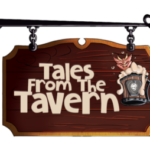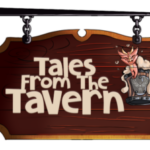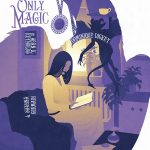By Jason Campbell and GamerMomLuna
In a recent episode of Daniel Norton and KR King’s Monsters & Treasure podcast they discussed meta currency in RPGs; for instance inspiration in Dungeons & Dragons 5e. This is a fascinating topic as games continue to create different systems for meta currency. Meta currency is a term used to describe any system of points which players can accumulate and spend to gain benefits in a RPG, often without a direct tie to the story being created. Role playing games are always a combination of story and game mechanics, and the use of meta points highlights that these are games, for better or worse. Which system is favored at your table will reflect how much the players are comfortable with game mechanics that might not be “realistic” in the fiction of the story but are fun in the game. Here’s a small sampling of meta points used by several RPGs, and some comments on the system.
Dungeons & Dragons Fifth Edition
Inspiration in the 2014 version of the D&D rules gets interpreted in different ways, but the rules as written are somewhat restrictive. A PC can only have 1 inspiration “point” at a time, and you spend them before a d20 roll to gain advantage on the roll. Note that as written a player can’t roll and then decide to spend inspiration, although many DMs rule it this way.
One potential flaw in this system is that as written the player must declare that they will use inspiration before rolling the dice. This has the potential that the player might spend inspiration and then roll a natural 20 on the first die, effectively wasting the inspiration point. This is especially disappointing because players are limited to a single inspiration.
Tales of the Valiant
Kobold Press’s 5e based game Tales of the Valiant (final rules to be released in May of 2024) uses a different system called luck points. PCs gain a luck point when they fail an attack or save roll, or the GM can award them for surviving difficult encounters, coming up with creative ideas or demonstrating excellent role playing. Each PC can only have a maximum of 5 luck points at a time. If they have 5 luck points and would gain another, they instead roll a d4 and reset their total number of luck points to the results of that roll. Luck points can be spent to increase any d20 roll at a rate of 1 point per luck point spent. Alternatively a player can spend 3 luck points immediately after you make an ability check, attack roll or save to reroll the d20 roll.
The goal of the luck point limit is to encourage players to use them instead of hoarding them. The way the rules are constructed is potentially flawed. If a player has 5 luck points and fails a roll, they should gain a sixth luck point, triggering the limitation reset. They could spend 3 luck points to reroll. If they don’t, their luck points get reset to 1-4. But if they do, they’ll spend 3 points, lowering their luck score to 2 on a successful reroll, or lowering it to 2, but immediately having it reset to 3 on a failure on the reroll.
Ultimately this system is almost a mini game within a game, so whether your table will enjoy it is to be determined.
Daggerheart
Darrington Press’s Daggerheart RPG (currently in beta) uses 2d12 for action rolls, with one die representing hope and the other representing fear. If the hope die rolls higher the player gains a hope point, but if the fear die rolls higher the GM gains a fear point. These points can be spent to end or activate effects.
The idea of the GM having fear points is intriguing, and at first read might seem to encourage adversarial GMing. It works as long as the table understands the mechanic in use. This should probably be discussed during session zero. I’ve not run Daggerheart yet, so I’ll reserve further judgments.
Kids on Bikes/Brooms
Kids on BIkes, Kids on Brooms and Teens in Space use a system of adversity tokens. Each time a player fails at a stat check they receive an adversity token. A player can spend an adversity token to increase the result of a stat check at a cost of +1 per token. In certain situations these can be spent to help another player succeed on a roll.
The adversity token system is purely a meta game mechanic with the major benefit that if a player is having a very bad day rolling dice, they at least are getting something positive. The tables I’ve played at loved this just because it makes the game more fun.
Index Card RPG
A GM in Index Card RPG can give a player a hero coin for a creative solution, great role playing or any other action that works for the table. Each player can only have 1 hero coin at a time. At any time a player can spend a hero coin to aid in a roll for their PC or any other PC in the party. The player can either reroll, or add the results of a d12 to the results of the roll.
Index Card RPG uses all the traditional dice (d4, d6, d8, d10 and d12), which makes the use of adding the results of a d12 more intriguing. A character might have an attack that does 1d4 damage, and adding a d12 to that result can have a serious impact. It can make things really swingy, but if your table is ok with that it is really fun.
EZd6
In EZd6 each player starts a session with 3 karma. The referee (known as the Rabble Rouser in the game) can give additional karma during the game for creativity or great role playing. Additionally anytime a PC fails an action roll they gain a karma. You can only get 1 karma per turn no matter what. You can spend karma to improve a die roll at a rate of +1 per karma.
Starting each session with 3 karma and adding one with each failure sets the stage that each player will likely have some number of karma at any time. Because they can only be used to increase rolls by +1 would seem to balance it, but note that this system only uses d6, with a result of 6 being a perfect success. Having several karma can really affect the game.
Cypher System
Cypher System based RPGs are a bit different because XP can be used for multiple things. GMs can award XP in different ways such as for creative ideas, great role playing, or achieving milestones. Cypher also has the notion of the GM Intrusion, where the GM offers a player (or the group) the option of accepting a change in the direction of the story or situation (whether positive, neutral or negative), and in exchange the player receives one XP and another which must be immediately given to another player at the table.
XP can be used to reroll a d20 roll, but they can also be used for a Player Intrusion. A Player Intrusion is similar to a GM Intrusion, but the effect should be agreed on by the GM and player. The complication is that XP can also be saved and used to advance the PC towards the next tier (level).
The use of XP for in game player aid and for PC advancement leads to really intriguing decisions by players. It likely leads to PCs being different tiers in a longer campaign, as some players hoard XP for advancement advantages while others spend them in game for the advantages they give. Note that many GMs in cypher system games award “in game” XP for use only for player intrusions and rerolls, and award “advancement” XP separately for tier advancement.
Call of Cthulhu
Call of Cthulhu uses the luck score. Each PC has a luck score determined at the start of the game and in game a PC might need to roll percentile dice, succeeding on a roll equal to or under their current luck score. During the game players can spend some of their luck score to add points to the target in order to succeed on a roll in some situations.
The luck score system fits in well with the desperate nature of Call of Cthulhu in general. Players will inevitably need to spend luck points, which then lessens their chance of success on luck rolls. It leads to a sort of “doom spiral” where a PCs chance of success is lowered as the games go on.
What do you think? What’s your favorite meta point system? Which ones did we miss that deserve discussion? Let us know in the comments.







